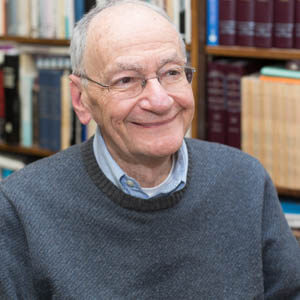
The Sanctity of the Land
Apr 30, 1994 By Ismar Schorsch | Commentary | Emor | Pesah | Shavuot | Sukkot
At the new Jewish Museum one can feast on the panorama of Jewish history in a single spectacular, permanent exhibition, subtly conceived and brilliantly executed. It opens with a replica of an ancient agrarian calendar found in 1908 at Gezer, northwest of Jerusalem in the Shefela region. Written in good biblical Hebrew, the calendar seems to date from the 10th century B.C.E., coinciding with the reign of Solomon, when Gezer became part of the expanding monarchy of Israel. The calendar may not be anything more than a mnemonic ditty for children, and yet it is a cultural artifact of rich significance.
Read More
Finding Sanctity in Community
May 17, 1997 By Ismar Schorsch | Commentary | Emor
In Judaism certain religious acts require a minyan. We do not chant from the Torah scroll or recite a haftara without a quorum. For a cantor to lead services that include the recitation of the blessing barkhu or the kedusha in the amida or a mourner’s kaddish likewise needs the presence of a minyan. So does a wedding. Moments of peak sanctity call for community. We attain a sense of God’s concern by entering a space filled with kindred souls. In public worship, Jews past and present are united to in fuse us with the spiritual power to reach for the transcendent.
Read More
Claiming Our Spiritual Freedom
May 14, 2005 By Ismar Schorsch | Commentary | Emor
The laws of the Torah are rooted in the exodus from Egypt.
Read More
Israel’s Destiny
May 16, 1998 By Ismar Schorsch | Commentary | Emor | Lag Ba'omer
Jews mark the period between the festivals of Passover and Shavuot by the counting of the omer. For a period of 49 days, beginning on 16 Nisan, for us in the diaspora the night of the second Seder, we count each day at the evening service (the start of a new day in the Jewish calendar) in terms of the days and weeks that have passed. This brief ceremony opens with the verse in this week’s parasha that sets forth the prescription: “And from the day on which you bring the sheaf of elevation – the day after the sabbath – you shall count off seven weeks. They must be complete: you must count until the day after the seventh week – fifty days (Leviticus 23:15–16).”
Read More
Fulfilling the Commandments
May 1, 1999 By Ismar Schorsch | Commentary | Emor
Piety and morality diverged once again recently when Rabbi Hertz Frankel, the English studies principal of Beth Rachel (the network of Satmar girls’ schools in the Brooklyn neighborhood of Williamsburg), pleaded guilty to embezzling more than six million dollars of public funds over nearly two decades for the welfare of his employer. Despite a light sentence –– three years of unsupervised probation and a fine of one million dollars on Beth Rachel –– Rabbi Frankel was unrepentant. “The end justifies the means,” he told the New York Times, which I take to mean that he believed the Jewish children in his care were more deserving of the money than the non–Jewish children, no less impoverished and deprived, who lived in his school district.
Read More
The Origins of Sacrifice
May 13, 2000 By Ismar Schorsch | Commentary | Emor
When our three children were still quite young, we did not hesitate to let them masquerade for Halloween and go out to “trick or treat.” For security reasons, we would often go with them. Part of the evening’s fun was handing out the candy at our own door to those who came seeking a treat. The Orthodox day school which our children attended at the time frowned on the practice by insisting that Halloween was once a Christian religious holiday. The sudden display of pedanticism always amused me because what was left of Halloween in our day is utterly bereft of any sacred content. Like Valentine’s Day, it had been completely desacralized, and most American Jews participated in the joy of both days in some fashion. Time had severed the modern secular meaning of each from its medieval religious moorings. The Orthodox assault was not driven by a sudden appreciation for critical scholarship but by an overriding concern for keeping Jews socially apart as much as possible.
Read More
Kindling the Light of Torah
May 12, 2001 By Matthew Berkowitz | Commentary | Emor
This past week the JTS community gathered together to celebrate the completion of the Kripke Tower. This magnificent tower blesses JTS with more classroom space, a state–of–the–art music studio and language lab, and a video conferencing center which will serve the needs of students, faculty and staff. Even the entryway conveys a message of mutuality, as light from outside filters through the glass breezeway, while light from the interior courtyard reflects back out to the street. One final detail of architectural insight will crown the Kripke Tower when it is officially dedicated in just under two weeks. As JTS enhances its capacity to spread its message of Torah and mitzvot throughout the Jewish world, an everlasting light (ner tamid) will be lit at the top of the tower guarding over JTS.
Read More
From Gleaning to Tzedakah
May 10, 2003 By Ismar Schorsch | Commentary | Emor
Words often conceal the origins of the idea they denote. Etymology and meaning diverge and thus confound. A good example relates to a halakhic fragment in this week’s parasha. I refer to the verb “to glean.” The word denotes minimal gain through hard work. Basically an agricultural term, it conjures up an image of beggars at harvest time gathering whatever remains in the field after reaping. From there the meaning expands to any activity, physical or mental, that involves collecting painstakingly individual items of the same order from disparate quarters.
Read More


